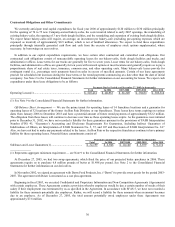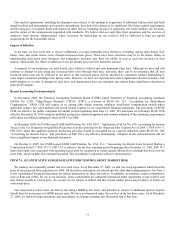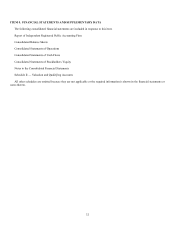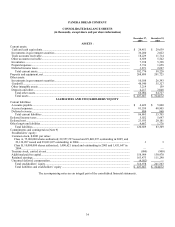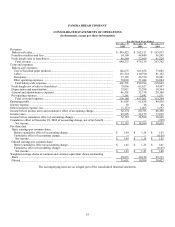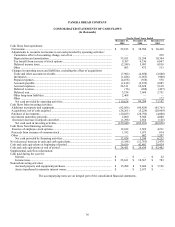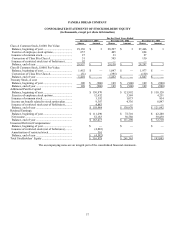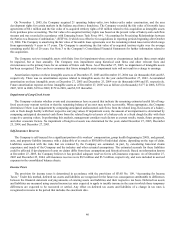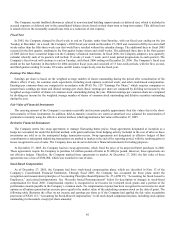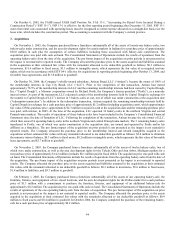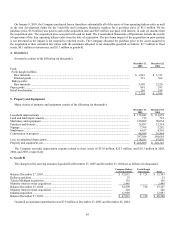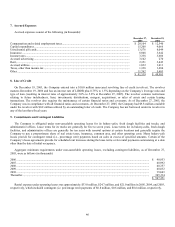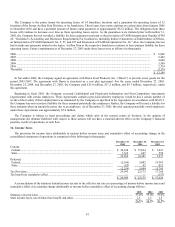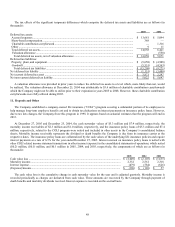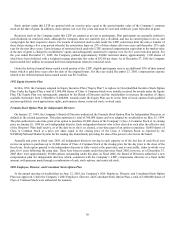Panera Bread 2005 Annual Report Download - page 46
Download and view the complete annual report
Please find page 46 of the 2005 Panera Bread annual report below. You can navigate through the pages in the report by either clicking on the pages listed below, or by using the keyword search tool below to find specific information within the annual report. 40
On November 1, 2005, the Company acquired 21 operating bakery-cafes, two bakery-cafes under construction, and the area
development rights for certain markets in the Indiana area from a franchisee. The Company recorded the fair value of favorable lease
agreements of $0.1 million and the fair value of re-acquired territory rights of $3 million related to this acquisition as intangible assets
in its purchase price accounting. The fair value of re-acquired territory rights was based on the present value of bakery-cafe cash flow
streams and was recorded in accordance with Emerging Issues Task Force 04-1, “Accounting for Preexisting Relationships between
the Parties to a Business Combination,” (EITF 04-1) which was effective for acquisitions in reporting periods beginning after October
13, 2004. The Company is amortizing the fair value of favorable lease agreements over the remaining related lease terms which range
from approximately 9 years to 17 years. The Company is amortizing the fair value of re-acquired territory rights over the average
remaining useful life of 20 years. See Note 3 to the Company’s Consolidated Financial Statements for further information related to
this acquisition.
The Company reviews intangible assets with finite lives for impairment when events or circumstances indicate these assets might
be impaired, but at least annually. The Company tests impairment using historical cash flows and other relevant facts and
circumstances as the primary basis for an estimate of future cash flows. As of December 27, 2005, no impairment of intangible assets
has been recognized. There can be no assurance that future intangible assets impairment tests will not result in a charge to earnings.
Amortization expense on these intangible assets as of December 27, 2005 and December 25, 2004 was (in thousands) $46 and $3,
respectively. There was no amortization expense related to intangible assets for the year ended December 27, 2003. Accumulated
amortization on these intangible assets at December 27, 2005 and December 25, 2004 was (in thousands) $49 and $3, respectively.
Future amortization expense on these intangible assets as of December 27, 2005 was as follows (in thousands): $177 in 2006, $178 in
2007, $181 in 2008, $176 in 2009, $172 in 2010, and $2,335 thereafter.
Impairment of Long-Lived Assets
The Company evaluates whether events and circumstances have occurred that indicate the remaining estimated useful life of long-
lived assets may warrant revision or that the remaining balance of an asset may not be recoverable. When appropriate, the Company
determines if there is an impairment by comparing anticipated undiscounted cash flows from the related long-lived assets of a bakery-
cafe or fresh dough facility with their respective carrying values. If impairment exists, the amount of an impairment is determined by
comparing anticipated discounted cash flows from the related long-lived assets of a bakery-cafe or a fresh dough facility with their
respective carrying values. In performing this analysis, management considers such factors as current results, trends, future prospects,
and other economic factors. No impairment of long-lived assets was determined for the years ended December 27, 2005, December
25, 2004, and December 27, 2003.
Self-Insurance Reserves
The Company is self-insured for a significant portion of its workers’ compensation, group health (beginning in 2005), and general,
auto, and property liability insurance with a deductible of as much as $500,000 of individual claims, depending on the type of claim.
Liabilities associated with the risks that are retained by the Company are estimated, in part, by considering historical claims
experience and trends of the Company and the industry and other actuarial assumptions. The estimated accruals for these liabilities
could be affected if development of costs on claims differ from these assumptions and historical trends. Based on information known
at December 27, 2005, the Company believes it has provided adequate reserves for its self-insurance exposure. As of December 27,
2005 and December 25, 2004, self-insurance reserves were $8.9 million and $3.5 million, respectively, and were included in accrued
expenses in the consolidated balance sheets.
Income Taxes
The provision for income taxes is determined in accordance with the provisions of SFAS No. 109, “Accounting for Income
Taxes.” Under this method, deferred tax assets and liabilities are recognized for the future tax consequences attributable to differences
between the financial statement carrying amounts of existing assets and liabilities and their respective tax basis. Deferred tax assets
and liabilities are measured using enacted income tax rates expected to apply to taxable income in the years in which those temporary
differences are expected to be recovered or settled. Any effect on deferred tax assets and liabilities of a change in tax rates is
recognized in income in the period that includes the enactment date.


